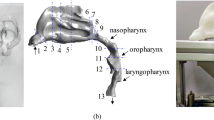Summary
This study aimed to use computer simulation to describe the fluid dynamic characteristics in patients with obstructive sleep apnea syndrome (OSAS) and to evaluate the difference between during quiet respiration and the Muller maneuver (MM). Seven patients with OSAS were involved to perform computed tomographic (CT) scanning during quiet respiration and the MM. CT data in DICOM format were transformed into an anatomically three-dimensional computational fluid dynamics (CFD) model of the upper airway. The velocity magnitude, relative pressure, and flow distribution were obtained. Numerical simulation of airflow was performed to discuss how the MM affected airflow in the upper airway. To measure the discrepancy, the SPSS19.0 software package was utilized for statistic analysis. The results showed that the shape of the upper airway became narrower, and the pressure decreased during the MM. The minimal cross-sectional area (MCSA) of velopharynx was significantly decreased (P<0.05) and the airflow velocity in MCSAs of velopharynx and glossopharynx significantly accelerated (P<0.05) during the MM. This study demonstrated the possibility of CFD model combined with the MM for understanding pharyngeal aerodynamics in the pathophysiology of OSAS.
Similar content being viewed by others
References
Malhotra A, White DP. Obstructive sleep apnea. Lancet, 2002,360(9328):237–245
Caballero P, Alvarez-Sala R, Garcia-Rio F, et al. CT in the evaluation of the upper airway in healthy subjects and in patients with obstructive sleep apnea syndrome. Chest, 1998,113(1):111–116
Fogel RB, Malhotra A, White DP. Sleep. 2: pathophysiology of obstructive sleep apnoea/hypopnoea syndrome. Thorax, 2004,59(2):159–163
Xiao Y, Chen X, Shi HS, et al. Evaluation of airway obstruction at soft palate level in male patients with obstructive sleep apnea/hypopnea syndrome: dynamic 3-Dimensional CT imaging of upper airway. J Huazhong Univ Sci Technol, 2011,31(3):413–418
Mylavarapu G, Murugappan S, Mihaescu M, et al. Validation of computational fluid dynamics methodology used for human upper airway flow simulations. J Biomech, 2009,42(10):1553–1559
Sung SJ, Jeong SJ, Yu YS, et al. Customized three-dimensional computational fluid dynamics simulation of the upper airway of obstructive sleep apnea. Angle Orthod, 2006,76(5):791–799
Yu CC, Hsiao HD, Lee LC, et al. Computational fluid dynamic study on obstructive sleep apnea syndrome treated with maxillomandibular advancement. J Craniofac Surg, 2009,20(2):426–430
Ito Y, Cheng GC, Shih AM, et al. Patient-specific geometry modeling and mesh generation for simulating obstructive sleep apnea syndrome cases by maxillomandibular advancement. Math Comput Simul, 2011,81(9):1876–1891
Moyin Z, Tracie B, Peter C, et al. Computational fluid dynamics for the assessment of upper airway response to oral appliance treatment in obstructive sleep apnea. J Biomech, 2013,46(1):142–150
Terris DJ, Hanasono MM, Liu YC. Reliability of the Muller maneuver and its association with sleep-disordered breathing. Laryngoscope, 2000,110(11): 1819–1823
Tan J, Han D, Wang J, et al. Numerical simulation of normal nasal cavity airflow in Chinese adult: a computational flow dynamics model. Eur Arch Otorhinolaryngol, 2012,269(3):881–889
Qian Y, Qian H, Wu Y, et al. Numeric simulation of the upper airway structure and airflow dynamic characteristics after unilateral complete maxillary resection. Int J Prosthodont, 2013,26(3):268–271
Mohsenin V. Effects of gender on upper airway collapsibility and severity of obstructive sleep apnea. Sleep Med, 2003,4(6):523–529
Liao YF, Huang CS, Chuang ML. The utility of cephalometry with the Muller Maneuver in evaluating the upper airway and its surrounding structures in Chinese patients with sleep-disordered breathing. Laryngoscope, 2003,113(4):614–619
Borowiecki BD, Sassin JF. Surgical treatment of sleep apnea. Arch Otolaryngol, 1983,109 (8):508–512
Sher AE, Thorpy MJ, Shprintzen RJ, et al. Predictive value of Muller maneuver in selection of patients for uvulopalatopharyngoplasty. Laryngoscope, 1985,95(12):1483–1487
Li S, Shi H, Dong X, et al. Quantitative evaluation of the upper airway by CT scan with the Muller maneuver. Lin Chuang Er Bi Yan Hou Ke Za Zhi (Chinese), 2005,19(3):104–107
Yan ZQ, Sun JJ, Chen X, et al. Real-time CT of upper airway in patients with obstructive sleep apnea hypopnea syndrome. Zhonghua Er Bi Yan Hou Tou Jing Wai Ke Za Zhi (Chinese), 2013,48(4):284–288
Author information
Authors and Affiliations
Corresponding author
Additional information
The authors contributed equally to this work.
This study was supported by grants from Shanghai College Young Teacher Training Program (No. shjdy029) and Youth Projects of Shanghai Municipality Health and Family Planning Commission (No. 20144Y0124).
Rights and permissions
About this article
Cite this article
Nie, P., Xu, Xl., Tang, Ym. et al. Computational fluid dynamics simulation of the upper airway of obstructive sleep apnea syndrome by Muller maneuver. J. Huazhong Univ. Sci. Technol. [Med. Sci.] 35, 464–468 (2015). https://doi.org/10.1007/s11596-015-1454-x
Received:
Revised:
Published:
Issue Date:
DOI: https://doi.org/10.1007/s11596-015-1454-x




